
Thermal Designing and Building Transformers for Use with Viscous Fluids
Introduction and history Before the 1970s, transformers that needed to be fire resistant used dielectric fluids that contained chlorinated chemicals. These fluids were generally called...
byDavid Sundin

Introduction and history
Before the 1970s, transformers that needed to be fire resistant used dielectric fluids that contained chlorinated chemicals. These fluids were generally called PCB (Poly Chlorinated Biphenyl) or “Askerel” fluids. Because of the poor health and environmental characteristics of these PCB fluids, they were discontinued worldwide in the 1970s and replaced with newer types of fire resistant fluids.
These fluids usually relied on a high molecular weight to give them a low vapor pressure and therefore, fire resistance. Their high molecular weight also made these fluids more viscous than standard mineral oil. Transformer cooling designs had to be reworked in order to stay within standard temperature ranges when using these new fluids. When those new fire resistant fluids were introduced for use in transformers, manufacturers attempted to apply the fluids in transformers designed with rules that had been developed to use conventional transformer oil (like PCB). More often than not, the rules for transformer cooling with standard transformer oil had been developed over years of trial and error, and were specific to each design and brand of transformer. Temperature rise tests show that the higher fluid viscosity had little effect on winding temperature or top fluid temperature rises. However, temperature rise tests on larger transformers indicated that the top oil temperatures of transformers filled with these fluids ran 4 to 6 degrees warmer than the same transformer designs filled with conventional transformer oils. Figure 1. shows the increase in operating temperature between a fire resistant fluid (Alpha-1 Fluid from DSI Ventures, Inc.) and standard mineral transformer oil (in this paper, “Standard Transformer Oil” refers to mineral oil per ASTM Standard D3487 or IEC Standard 60296)
Table 1: Temperature differential when using fire resistant oil

In early applications of these fire resistant fluids, transformer manufacturers lowered the guaranteed kVA rating of transformers to compensate for increased temperature rises experienced during tests. Reductions in ratings varied from 0 for small transformers below 50 kVA to approximately 15% for a silicone fluid-filled transformer rated 1500 kVA, convection-cooled (ONAN) unit. Additional fans were generally used to meet the forced-air cooled (ONAF) ratings. Manufacturers recognised that, in order to comply with guaranteed temperature rises of standard ratings, that cooling designs needed to be modified when applied to transformers filled with fire resistant fluids.
The physical features of a transformer that have to be taken into account when predicting winding temperature and top oil temperature were derived in the 1930s and 1940s. They are the coil dimensions, tank dimensions, coil duct dimensions, external cooling equipment arrangements and dimensions, heat flux densities of the heat dissipation surfaces in the coils, the tank, and the external cooling equipment. Most manufacturers’ thermal calculation methods evolved from equations (2) (3) and (4) relating heat flux rate and temperature rises for oil filled transformer as proposed by Montsinger [1].







